“Conversions” are often loosely defined, and you’ll encounter some writers who will say a conversion has taken place when someone clicks through a different article, or socially shares your piece of content. For the purposes of this guide, however, we’ll focus on harder, more measurably valuable conversions—usually either securing a purchase or donation, or collecting some meaningful bits of personal information from a user. This guide’s intention is to teach you how to use content to get more of these hardline conversions for your site.
Table of Contents
Content vs. Copywriting
First, I need to acknowledge an important distinction between content writing and copywriting. Though similar, copywriting is typically short-form, and focused on persuading an audience to take a specific action. You’ll find this type of writing in advertisements frequently. See Trello’s ad as an example:
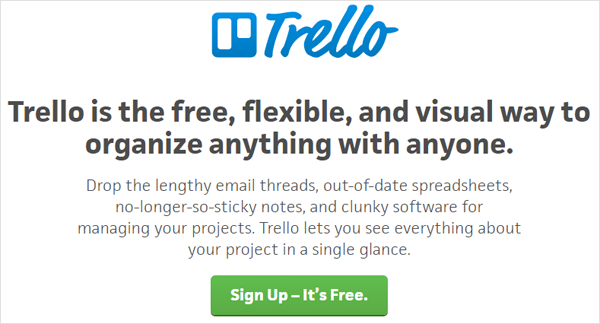
(Image Source: Trello)
Here, you have a catchy headline, a short description, and a CTA button. This is a fine example of copywriting, but it doesn’t have enough meat to be qualified as “content” in this sense. We’ll touch on elements of copywriting when we get to the section on in-content calls-to-action, but for the most part, everything in this guide will focus on actual content marketing.
The 3 Pillars of Content-Conversion Relationships
There are three main areas where content can affect your conversion rates, and I’m going to explore each of them in turn:
- Acquisition.First, there’s content’s capacity to earn you more visitors. Increased traffic, with a steady conversion rate, is going to result in a higher total number of conversions. Our goals here will be writing, publishing, and syndicating content across multiple channels to secure the greatest search volume and relevance of traffic to your site or landing page.
- Exchange. Content may also be used as an element of exchange, particularly when it comes to B2B conversions that only ask for personal information as a conversion event. This content must be equal to or greater in value than the information you’re requesting.
- Immediate conversion. There’s also the opportunity to leverage your content as a platform for immediate conversion. Here, you’ll be injecting CTAs into the body of your content in an effort to secure a completed conversion event.
Without further ado, let’s find out exactly how content can secure you the conversion rates you’ve always wanted.
Content as Acquisition
Let’s assume that you have a steady conversion rate. You’re happy with it, but you need more inbound traffic to scale your total number of conversions to a desirable level. The best thing to do here is focus on generating traffic—and even if your conversion rate leaves something to be desired, more traffic is going to help you eventually, so you might as well get started here.
Optimizing Content is your greatest tool for long-term traffic generation, because it can be used in three interrelated ways.
Onsite Content and SEO
Understand that every new piece of create content you create on your site is another web pages for Search engine or search engines to crawl and another opportunity for an average searcher to encounter your brand. My quick Google search for “SEO news” turned up three articles before even getting to the organic search results, and this certainly isn’t the only way to get more search visibility.
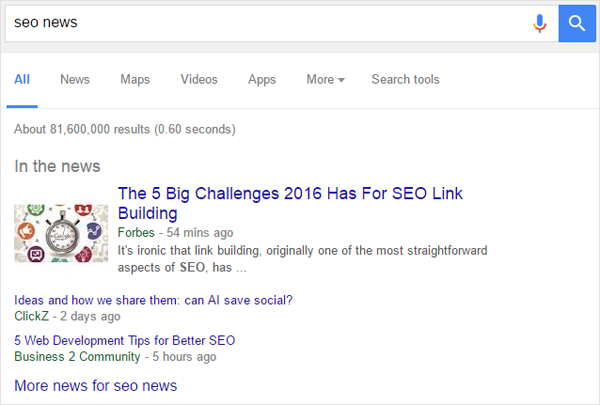
Writing more content gives your site more text for Search engines or other search engines to crawl, giving it a better understanding of your site. Each new piece is also an opportunity to rank for relevant keywords/user query. Accordingly, all your pieces should be:
- Highly specific. General topics, like “SEO,” are already done to death by major brands you probably can’t afford to compete with—plus Google’s Knowledge Graph may supply searchers with this general information before they ever encounter you. Choosing very specific topics will help you navigate around these competitive challenges, and secure you greater per-piece visibility.
- Desirable. Obviously, your content can only be found if people are actually searching for it. You’ll want to delve into some keyword research, competitive research, and into your current client base with surveys to ensure you’re selecting topics that people actually want to read. Generally, the more practical they are, the better.
- Targeted. Your inbound traffic is only going to convert if they’re comprised of your target demographics in a mid- to late-stage of the buying cycle. Write your content accordingly. Dig deep into your market research, and try to supply information for the types of people who are most likely to convert once on your site.
- Optimized. I won’t get into the specifics of SEO in this article, but know that your articles will have to meet certain search engine optimization (SEO) protocols to maximize their chances of being featured in SERPs. For example, title tags for the landing pages, title Tags for the home page/blog post, header tags, a meta descriptions, and visual elements should all be included.
Be aware that it takes time to develop your domain authority to the point where your content earns a substantial rank.
Offsite Content
Offsite content Marketing has two main purposes. The first is for SEO and organic visibility. Google sees inbound links as a form of third-party approval of a site; a link from a high-authority domain will “pass” authority to its intended destination, increasing its authority by proxy. This occurs on both a domain and page level, and is necessary if you want to earn any search engine rankings momentum.
The second is for referral traffic. Any link you build using an offsite piece of content will be clickable, and if the content is good enough, it will generate a substantial stream of More organic traffic to your site.
You can take advantage of both these benefits as long as you have a solid offsite content marketing campaign. Typically, this involves getting your content marketing featured on sources of increasing authority, from local news sites and forums to major national publishers. Again, I’ll stay out of the weeds on this, but I’ll leave you with a handful of important takeaways on how offsite content Marketing can best increase organic traffic ready to convert:
- Write stellar content. If you’re just stuffing links into mediocre material, you’ll lose referral traffic, and you might not even get accepted by external publishers in the first place.
- Know your audiences. Don’t write for a publisher whose audience is far outside your target demographics.
- Link to your key conversion opportunities. If you have specific landing pages or product web pages, link to them frequently to boost their page authority. If your homepage SEO helps double your conversion opportunities, that makes the optimization process even simpler:
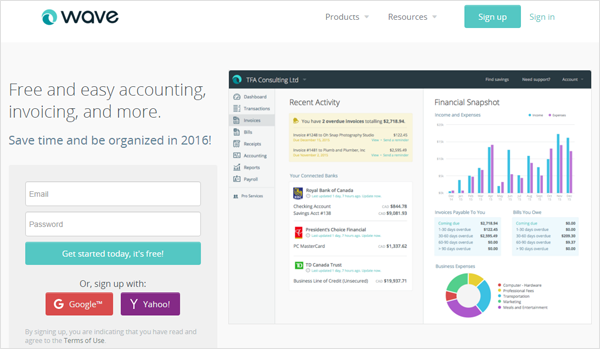
(Image Source: WaveApps)
Social Syndication
You can also use your Optimizing content as the “meat” for your social media campaign. Rather than constantly trying to goad your followers into visiting your site or buying your products, you’ll supply them with a near-constant stream of valuable content, which they can use to inform their decisions and build trust in your brand. Click-through rates on content are higher than for sales (typically), so use your content Marketing as a bridge to get your social users to your site, and sell them once they’ve crossed that bridge.
Of course, you’ll also have to work on building up your social audiences—the more dedicated, active followers you have, the higher impact your content optimization strategy/syndication will have on your bottom line. Remember to engage with your users, leverage the power of influencers to tap new markets, and remain as personal and active as possible.
Content as an Exchange
Conversions are always an opportunity of exchange; in conventional B2C settings, this involves a customer handing over money in exchange for a physical product. The more valuable this product is, the more likely it is that the consumer will partake in the exchange, giving you a critical opportunity to secure more conversions.
There are two scenarios in which content may be used as the “other half” of this exchange as a standalone value. The first is in a B2B setting, where your company is only after personal information of potential leads. Personal information is valuable, if only mildly, and people won’t part with it unless they know they’re getting something out of the deal. Content, a digital good with infinite replicability, serves the role of exchange here quite well.
Take HubSpot’s usual eBook offer as an example:
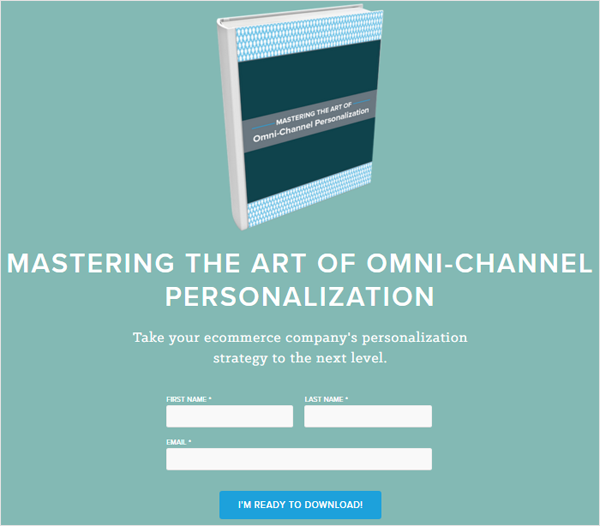
(Image Source: Hubspot)
The other scenario is one in which content is offered as the product in exchange for money, though an even higher standard of quality is demanded here. Still, both scenarios share much in common and can be used to the same ends.
Key Values
There are a handful of “must have” features for content you’re using as an exchange for conversion value:
- Originality. It was true for your onsite and offsite content, but here it’s even more important. Why would someone give you their personal information for an eBook that they can basically read elsewhere on the Internet for free? Original research and new data is imperative here to seal the deal.
- Practical value. Most people are willing to pay more (or give up more) for something that has a practical value than something that has a passing, or entertainment value. Give them something that could be qualified as an investment; teach them a new skill, or improve their lives in some meaningful way.
- Exclusivity. You can’t offer an eBook in exchange for personal information, then distribute that same eBook for free to your social media followers. Your content optimization strategy should be an exclusive offer for anyone willing to convert. It’s a way of introducing scarcity value and simultaneously making sure people feel like they got their money’s worth (or in this case, information’s worth).
- Length. Your eBook or whitepaper can’t be 1,000 words. Don’t stuff your content with fluff, either. Give your audience a long, detailed, yet still-concise piece.
- Authority. If you want people to follow through with the conversion before reading your piece, you need to convince them that it’s all you say it is. This means showcasing your authority, or otherwise proving that you have the qualifications to make this piece of content worth your visitors’ time. Referencing past works, noting your industry affiliations, and offering up reviews and testimonials are all good ideas here.
Balancing the Exchange
This is a tough consideration, since you won’t be dealing with any absolute values, but it’s an important one. Remember, a conversion is all about exchange, so you need to know how valuable each side of the exchange is to maximize the potential payoff.
For example, if you spent a year of your life doing the research and living the experiences that led you to write this eBook, asking for just a first name and an email address, or asking for $0.99 isn’t going to justify your work. On the other hand, if you invested a minimum in your original research, it isn’t fair to ask your customers for pages/blog post of personal information or $29.99.
There are two good ways to do this. The first is through research—take a look at your competition and see what they’re offering, and what they’re asking for in exchange. Use this comparatively to settle on the value of your own offers and requests.
The second is through experience. Experiment with different price levels and forms of content to see which prices and offers “stick.”
Previewing the Content
Most users won’t be satisfied with your promise that the content they’re about to receive is good enough to make the exchange. They need some kind of proof, or preview. At the same time, you don’t want to give away the secret sauce.
The solution is to give your users a tease—tell them what types of things they’re going to find in the body of your content, but don’t tell them the exact things they’re going to find. Take a look at how HubSpot handles this, identifying some of the quote contributors without giving away the actual quotes:

(Image Source: HubSpot)
In-Content Calls-to-Action
The third pillar of content-conversion relationships is probably the most important, as it directly affects your conversion rate in any context, rather than affecting only your inbound traffic figures or being limited to one application. The goal here is to include CTAs within the body of your onsite content, which is already doubling as a means of increasing search visibility and generating inbound organic traffic.
In some ways, these CTAs are like any other; they need to be short, compelling, accurate, and persuasive. However, if you want to retain the value and appeal of your content as is, you can’t go the traditional advertising approach in total.
Take Crazy Egg’s traditional advertisement as an example:
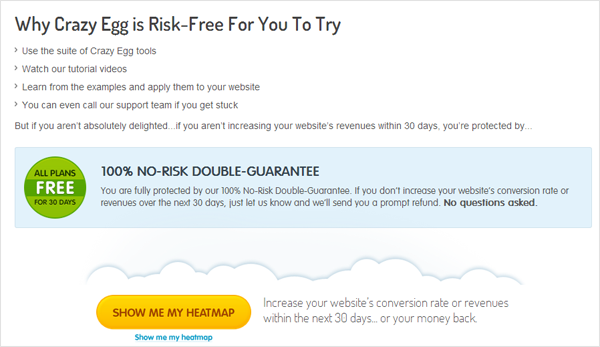
(Image Source: Crazy Egg/Wordstream)
This is a good example of an effective CTA, but it’s still an advertisement. This makes the CTA almost confrontational—pinning a user down with a pitch, and forcing them to either convert or depart. Instead, content-based CTAs are softer, and hinge on trust that you’ve already built with the quality and usefulness of your material.
Topic Selection
The first hurdle to overcome in maximizing the conversion potential of your content optimization is to choose the right topics. At a glance, this means selecting content topics within your area of expertise that your target market would find useful. For example, if you sell skateboards, it wouldn’t make sense to write content about the best types of office furniture for a startup. It would instead cater to individuals who might be in the market for a new skateboard, covering topics like “how to repair a broken axle” or the even-more-blunt, “how to choose your next skateboard.”
Try not to make your topics too sales-y, or it will turn people away. Buyer’s guides and product comparison articles are helpful, but if that’s all you put out, people will gradually feel alienated from you. Provide helpful, original material that a prospective buyer might read. Know your sales cycle inside and out, and target people at multiple stages to nurture them to a conversion.
Three Main Approaches
Once you’ve properly identified the right types of topics, you’re essentially halfway done with the battle. You’ll have a stream of optimal customer candidates reading your content. Now, your job is to guide them to a successful conversion. You can’t just stick a CTA in the middle of your article, so you have to use a subtler, more tactical approach.
There are three main approaches to in-content CTAs.
- The redirect. The redirect encourages users to head to a different section of the site. It doesn’t contain any pitch by itself, but instead compels a reader to discover content optimization that does the “pitching” on another section of the site. For example, let’s say you’re an HR consultant, and you have a dedicated landing page that explains what you do and asks users for personal information. In the body of one of your articles, you may include a reference to something like “this is just one of the many services an HR consultant can offer you,” with a link to your full list of services. Or you might be more direct with a straightforward request like, “for more information, check out my contact web pages/blog post.” This is advantageous because it keeps the primary focus on the value of your content optimization, rather than on the sales pitch, but disadvantageous because it delays the customer’s point of conversion.
- The casual mention. The casual mention is a discreet way to offer up one of your products or services in the body of your article. For example, if you sell clothing and you’re writing about this year’s biggest fashion trends, you can mention some of your top selling products, along with prices, as a kind of mini-sales-pitch. The same can work for B2B companies; for example, you can write something like, “link building is essential for search engine optimization (SEO) success, but you may need to hire an agency like SEO.co to execute the work professionally.” This is a harder sell, but it still doesn’t deviate far from the core of the article.
- The sales pitch. The sales pitch is essentially a mini advertisement, usually at the end of the article, that only loosely connects to the body of the article and instead focuses on getting the customer to a point of conversion. For example, at the end of an article on “X common skateboard repairs,” you could have a section with text like, “When you skate, you want the best. Our company offers top-of-the-line skateboards in al styles to make sure you perform your best.” Its weakness is that it deviates from the central value of your content optimization, but it also makes a harder sell.
Since each of these approaches has distinct advantages and disadvantages, I encourage you to use all three of them in rotation to maximize your potential payoff. If you notice one style outperforming the others, don’t be afraid to switch. Remember, your main priority here is to provide excellent content—if you have a great CTA embedded in an iffy, poorly written article, it isn’t going to land.
Similarly, you can’t just post a link and hope people will click. Your wording needs to be sharp, concise, compelling, and accurate—like any CTA—if you want your readers to convert.
Optimization and Improvement
You don’t have to be satisfied with your traffic, or your conversion rates. In fact, it’s almost a guarantee that your first-draft strategy isn’t going to earn you the best possible search results. The only way to improve your campaign is to take careful measurements of your most important metrics, make iterative changes, and then evaluate to see whether or not your changes were effective. Just be careful how you measure and report the differences—you never know how your biases may be affecting how you perceive the results.
One of the best ways to do this is through ongoing A/B testing. The basic premise of an A/B test is to create nearly identical scenarios, with one small difference between them, to see if one scenario outperforms the other. For example, you might write two highly similar articles with very different CTAs to see if one CTA performs better than the other. You can use this information to maximize the return on your future pieces.
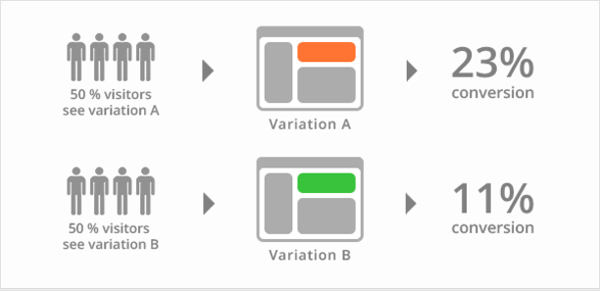
(Image Source: VWO)
You can change virtually anything and see a potential difference, but here’s a short list of ideas for your variables:
- Content topics, lengths, and target audience. The nature of your content optimization will have a huge bearing on the type of target audience who reads your material and their disposition by the time they get to your CTA. Don’t rule out the possibility of targeting a different audience altogether, and look to your competition to get inspiration for new content angles.
- Syndication channels and framing. There are hundreds of possible channels for you to distribute your content optimization, each with different target audience segments and different advantages and disadvantages. Get to know them, and experiment with different channels and angles to maximize your inbound content value.
- Content previews. This is exclusively for using content as a basis for exchange, but experiment with providing different previews for your offered material.
- Types of calls-to-action used. Rotate between redirects, casual mentions, and full-blown pitches. You may find that different angles work better for different applications, or that one in particular is ideal for your niche.
- Wording of calls-to-action used. Of course, you should also experiment with the copy you use in the body of your content to call out your products and services. Tiny differences, sometimes only a word or two, can make the difference. It also pays to change up the language so regular readers don’t get tired of the same message at the end of every piece.
Think of your content marketing strategy based as a constant, revolving experiment. The more ways you tinker with it, the more you’ll learn, and the better performance rate you’ll eventually earn.
Tim holds expertise in building and scaling sales operations, helping companies increase revenue efficiency and drive growth from websites and sales teams.
When he's not working, Tim enjoys playing a few rounds of disc golf, running, and spending time with his wife and family on the beach...preferably in Hawaii.
Over the years he's written for publications like Forbes, Entrepreneur, Marketing Land, Search Engine Journal, ReadWrite and other highly respected online publications. Connect with Tim on Linkedin & Twitter.
- What are the Different Types of Backlinks? - July 29, 2025
- Google E-E-A-T: Google’s E-E-A-T SEO Ranking Factor - July 16, 2025
- SEO Audit Guide: The Complete Guide to Running an SEO Audit - July 11, 2025



